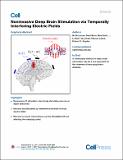Noninvasive Deep Brain Stimulation via Temporally Interfering Electric Fields
Author(s)
Rudenko, Andrii; Cassara, Antonino M.; Neufeld, Esra; Kuster, Niels; Pascual-Leone, Alvaro; Grossman, Nir; Bono, David C; Dedic, Nina; Kodandaramaiah, Suhasa Bangalore; Suk, Ho-Jun; Tsai, Li-Huei; Boyden, Edward; ... Show more Show less
Download1-s2.0-S0092867417305846-main.pdf (8.476Mb)
PUBLISHER_CC
Publisher with Creative Commons License
Creative Commons Attribution
Terms of use
Metadata
Show full item recordAbstract
We report a noninvasive strategy for electrically stimulating neurons at depth. By delivering to the brain multiple electric fields at frequencies too high to recruit neural firing, but which differ by a frequency within the dynamic range of neural firing, we can electrically stimulate neurons throughout a region where interference between the multiple fields results in a prominent electric field envelope modulated at the difference frequency. We validated this temporal interference (TI) concept via modeling and physics experiments, and verified that neurons in the living mouse brain could follow the electric field envelope. We demonstrate the utility of TI stimulation by stimulating neurons in the hippocampus of living mice without recruiting neurons of the overlying cortex. Finally, we show that by altering the currents delivered to a set of immobile electrodes, we can steerably evoke different motor patterns in living mice.
Date issued
2017-06Department
Massachusetts Institute of Technology. Department of Biological Engineering; Massachusetts Institute of Technology. Department of Brain and Cognitive Sciences; Massachusetts Institute of Technology. Department of Materials Science and Engineering; Massachusetts Institute of Technology. Media Laboratory; McGovern Institute for Brain Research at MIT; Picower Institute for Learning and MemoryJournal
Cell
Publisher
Elsevier
Citation
Grossman, Nir et al. “Noninvasive Deep Brain Stimulation via Temporally Interfering Electric Fields.” Cell 169, 6 (June 2017): 1029–1041 © 2017 Elsevier Inc
Version: Final published version
ISSN
0092-8674
1097-4172